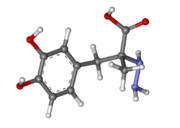Function
(Lodosyn) is a drug given, in conjunction with Levadopa, to those with Parkinson's Disease in order to inhibit the extracranial metabolism of Levadopa to dopamine, allowing a greater portion of the drug to cross the blood-brain barrier and produce the desired anti-parkinsonian effects in the nerve cell. It works by inhibiting the enzymatic activity of aromatic-L-amino-acid decarboxylase (DOPA Decarboxylase or DDC)[1].
Structure

2D Structure of Carbidopa

Ball and Stick Model of Carbidopa
Carbidopa is an inhibitor of DDC. It is a partially water soluble, white, crystalline compound with a molecular weight of 226.232g/mol and a melting point of 208°C. Its empirical formula is C10H14N2O4•H2O and its IUPAC name is (2S)-3-(3,4-dihydroxyphenyl)-2-hydrazinyl-2-methylpropanoic acid. Used in conjunction with Levadopa (L-DOPA), a precursor to dopamine, it increases concentrations of L-DOPA in the brain. Due to the fact Carbidopa cannot cross the blood–brain barrier, it inhibits only peripheral DDC thus preventing the conversion of L-DOPA to dopamine outside of neuronal cells. This greatly lessens the side effects caused by dopamine on the periphery, as well as increasing the concentration of L-DOPA and subsequently dopamine in the brain.
[2]
Molecular Mechanism
The conversion of L-DOPA into dopamine is catalyzed by the vitamin B6 ()-dependent enzyme DDC, an enzyme abundant in the nervous system as well as kidneys of humans[3] The catalytically active form of DDC is a homodimer, a feature typical of this class of enzymes[4]. DDCs active site is located between the two monomers but is mainly composed of residues from only one of the monomers. The cofactor PLP binds to Lys 303 through a Schiff base linkage and a salt bridge between the carboxylate group of Asp 271 and the protonated pyridine nitrogen of PLP, which acts as a strong electron sink capable of stabilizing the carbanionic intermediates produced by active DDC. the cofactor is further stabilized in the enzyme through a network of hydrogen bonds. Carbidopa works by forming a hydrazone linkage with the PLP cofactor through its hydrazine moiety and blocking the DDC residues Ile 101' and Phe 103' in the substrate binding pocket with its catechol ring[5]. In addition, the 4' hydroxyl group of Carbidopas catechol ring hydrogen bonds with THR 82 and the carboxylate group binds to HIS 192, a highly-conserved residue in PLP-dependent decarboxylases.[6] Due to the fact that Carbidopa cannot cross the blood-brain barrier, its inhibiting effects only are displayed in the periphery.
Interactions
Carbidopa only interactions include dopamine and Levodopa. Carbidopa works by inhibiting the enzyme activity of DDC, when both are working in the system it blocks the Levodopa negative side effects Levodopa is lipid soluble so it can pass the blood-brain barrier where Carbidopa cannot.
Disease in Humans
Parkinson's disease (PD) is a chronic, progressive neurological disease whose symptoms include bradykinesia, tremors, postural instability and rigidity. Although the exact cause of the disease is currently unknown, it is believe to be caused by the apoptosis of dopanergic cells in the substantia nigra of the brain and subsequent loss of dopamine.[7]Carbidopa is mostly related to people with Parkinson’s disease. According to the National Parkinson Foundation, Levodopa alone is known to cause nausea and vomiting in Parkinson’s patients, and Carbidopa prevents those side effects. Carbidopa can act as an enhancer for Levodopa by decreasing the dosage of Levodopa needed for Parkinson’s patients, about 80%. Current treatments for Parkinson’s disease are combined tablet of Carbidopa and Levodopa (Sinemet), which are offered as immediate-release tablets and slow-release tablets, along with dissolvable tablets.




